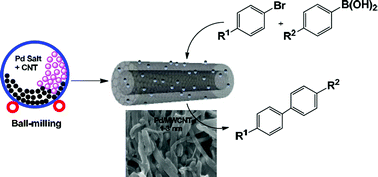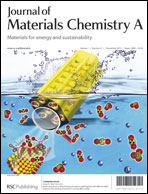Palladium nanoparticles supported on carbon nanotubes from solventless preparations: versatile catalysts for ligand-free Suzuki cross coupling reactions†
Abstract
Palladium nanoparticles supported on single- or multi-walled carbon nanotubes (Pd/SWCNT and Pd/MWCNT) were prepared by a rapid, solventless method that does not require reducing agents or electric current. The method involves a straightforward process using dry mixing of a precursor Pd salt (e.g., palladium acetate) with carbon nanotubes at ambient temperature by ball-milling (mechanochemical route) or with subsequent annealing at 300 °C (thermal route) in an inert atmosphere. The Pd/MWCNT sample with Pd nanoparticle size of 1–3 nm and uniform dispersion prepared by mechanochemical ball-milling at room temperature [designated as (Pd/MWCNT)M] displayed remarkable catalytic activity towards Suzuki cross coupling reactions with a high turn over number (TON) of 7250 and turn over frequency (TOF) of 217 500 h−1. These nanoparticles were characterized by a variety of techniques including transmission electron microscopy (TEM), X-ray diffraction (XRD) and X-ray photoelectron spectroscopy (XPS). Additionally, the (Pd/MWCNT)M sample was successfully employed in Suzuki cross coupling reactions with a wide variety of functionalized substrates.


 Please wait while we load your content...
Please wait while we load your content...